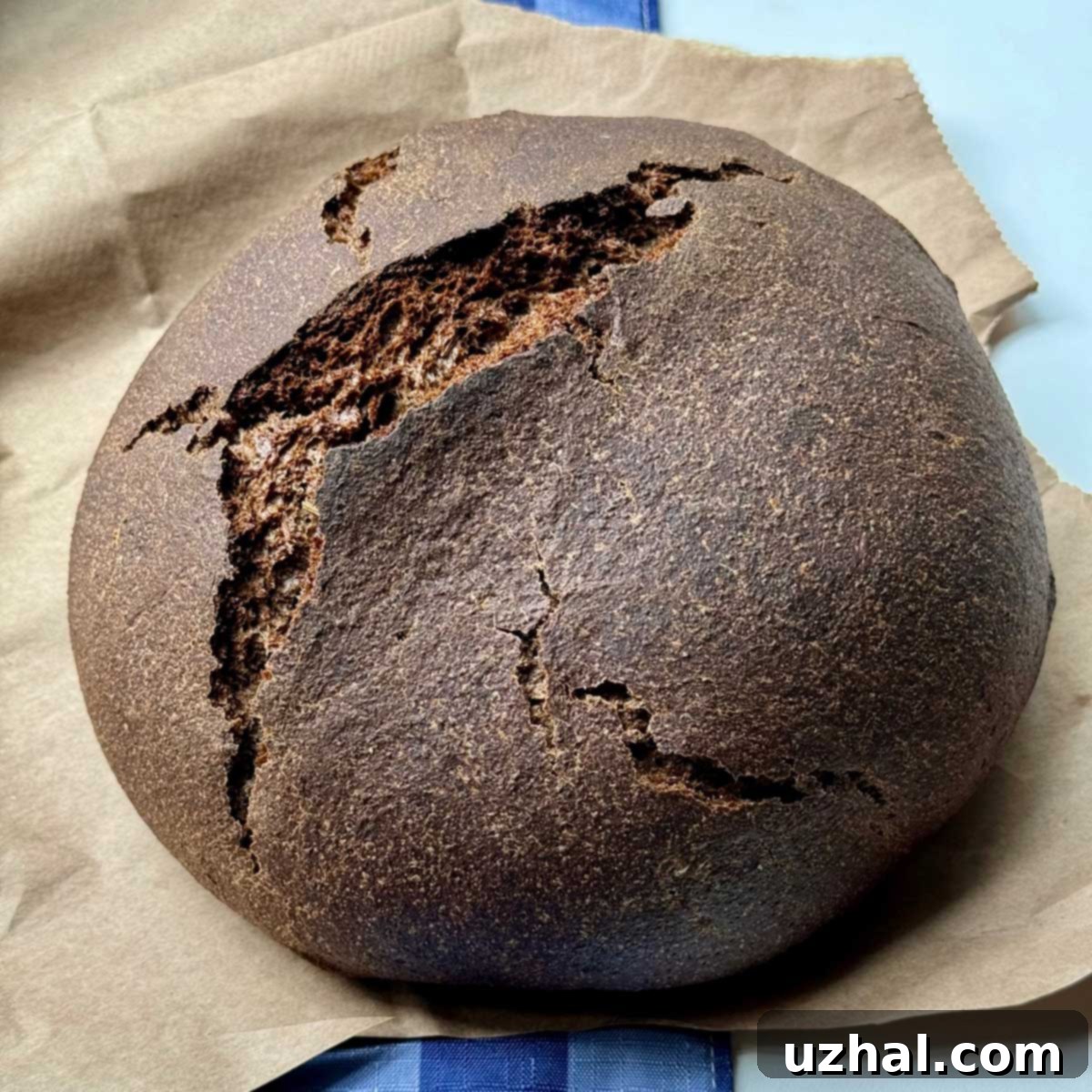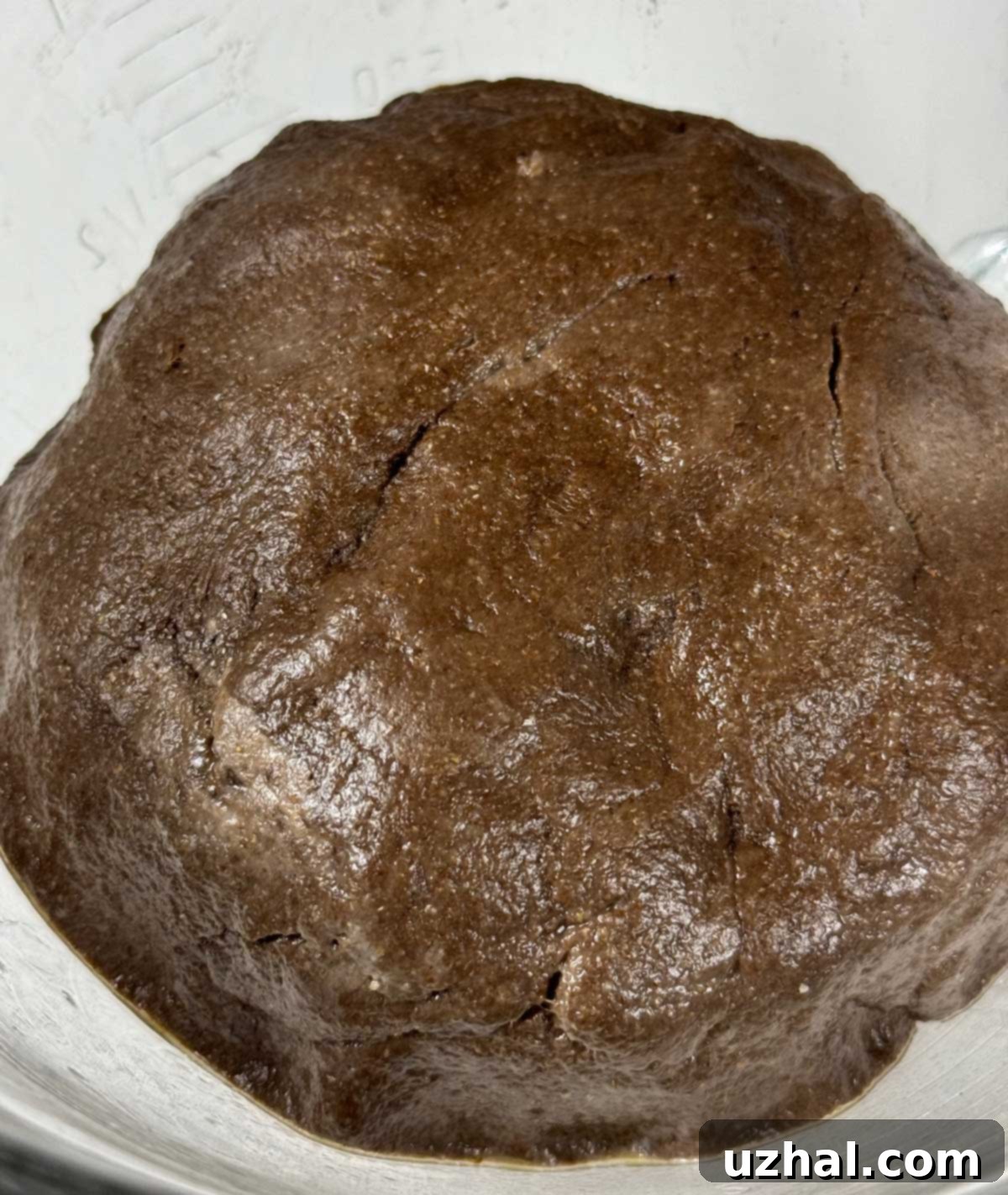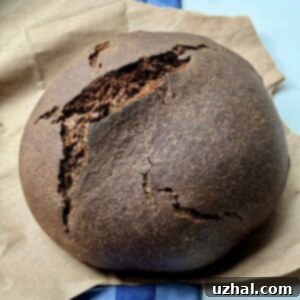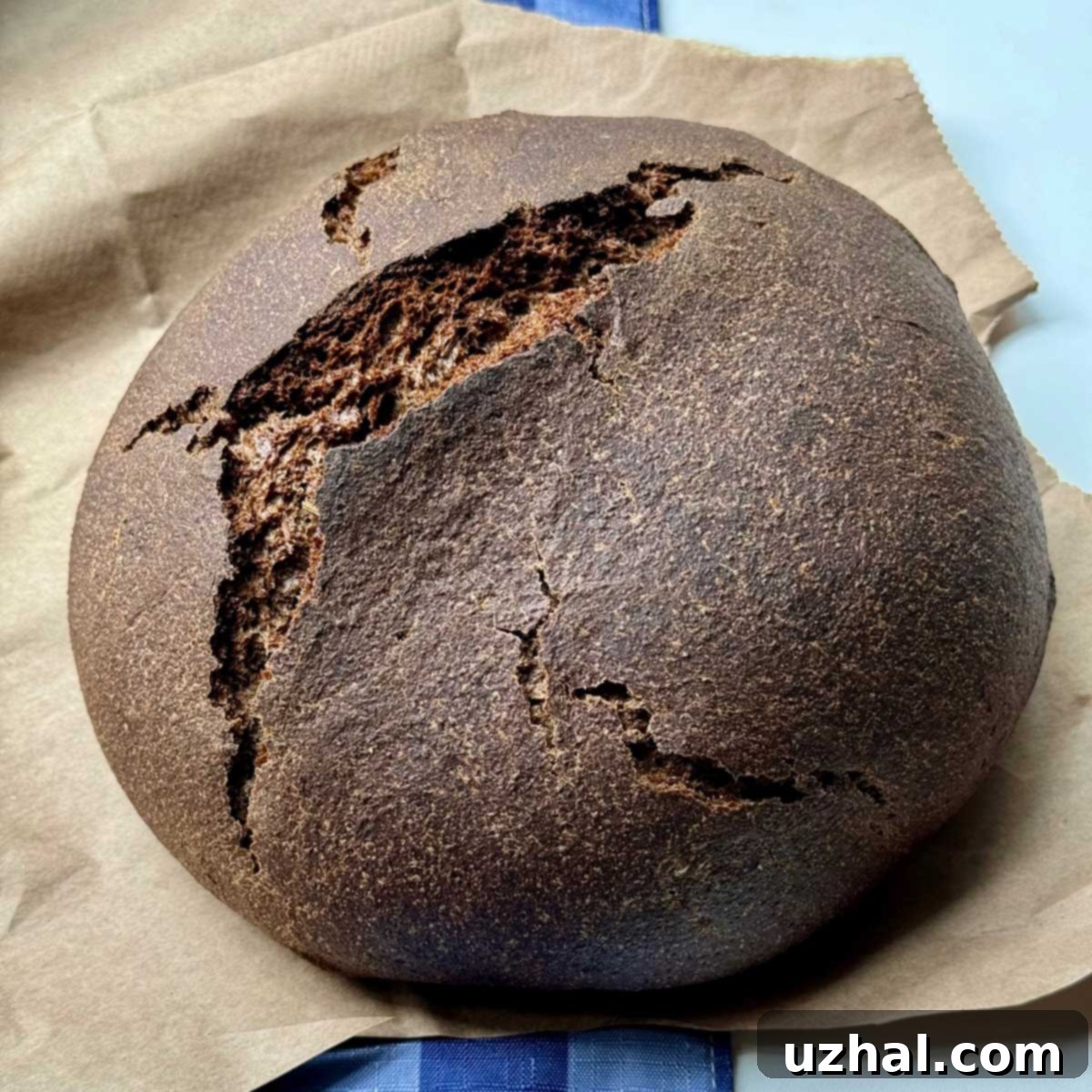Homemade Dark Rye Bread: The Ultimate Yeast Recipe with Rich Cocoa and Tangy Mustard Notes
Embark on a culinary journey to bake an extraordinary Dark Rye Bread right in your kitchen. This recipe draws inspiration from Mary’s beloved quick bread, but we elevate it by introducing the satisfying depth and texture that only yeast can provide. After years of perfecting, this yeast-leavened dark rye bread has become a family favorite, delivering a wonderfully rich flavor and a robust crumb that slices neatly. It’s an ideal choice for crafting small, flavorful sandwiches or for toasting to golden perfection, ready to be slathered with butter or your favorite spreads. The secret to its distinctive character lies in an unexpected yet harmonious blend of unsweetened cocoa powder and prepared yellow mustard, ingredients that add an incredible depth of color and a subtle, intriguing tang that will surprise and delight your palate.

The Allure of Homemade Dark Rye Bread
There’s something incredibly rewarding about baking your own bread, and this dark rye recipe is no exception. While many home bakers might gravitate towards simpler quick breads, taking the time to work with yeast introduces a complexity of flavor and a satisfying texture that can’t be replicated. This particular dark rye stands out for its deep, malty flavor, balanced by the subtle notes from its unique ingredients. It’s a bread that feels substantial yet remains wonderfully soft on the inside, with a perfectly chewy crust. Unlike some more involved rye recipes, this one uses readily available pantry and freezer staples, making it an accessible project for any home baker.
Many dark rye bread recipes, such as the beloved Russian Black Bread, call for a wider array of specialty ingredients. While those can be delicious, this recipe offers a fantastic alternative, delivering similar robust flavors with a simpler ingredient list. It’s a great choice for when you’re in the mood for an authentic dark rye but want to use what you already have on hand. The dough itself is a marvel to work with, developing a beautiful dark hue even before baking, promising the rich color that dark rye is known for. The aroma that fills your kitchen while it bakes is simply intoxicating!

Unveiling the Secret Ingredients: Cocoa and Mustard
What gives this Dark Rye Bread its distinctive edge and depth of flavor? It’s the ingenious combination of unsweetened cocoa powder and prepared yellow mustard. These aren’t just arbitrary additions; they serve specific purposes that contribute significantly to the bread’s overall profile. The cocoa powder, particularly a dark or black cocoa if you have it, isn’t there to make the bread taste like chocolate. Instead, it deepens the bread’s color, giving it that characteristic rich, dark appearance often associated with traditional European rye breads. More importantly, it adds a subtle earthiness and complexity that enhances the inherent flavors of the rye flour without overpowering them.
The prepared yellow mustard is an even more surprising hero. Much like how a pinch of coffee can enhance chocolate, mustard works wonders with rye. It provides a barely perceptible tang and a slight savory note that brightens the overall flavor profile. It cuts through the richness and earthiness, adding a layer of complexity that keeps you coming back for more. Don’t worry, your bread won’t taste like mustard! Its contribution is purely a background note, a subtle hint that makes the bread more intriguing and elevates it beyond a standard loaf. These two ingredients work in tandem to create a symphony of flavors that are unique and deeply satisfying, making this dark rye bread truly special.
Mastering the Bake: Dutch Oven vs. Conventional Oven
The baking method can significantly impact the final texture and crust of your homemade bread. For those who appreciate an artisan-style crust with a moist interior, baking this Dark Rye Bread in a Dutch oven is highly recommended. The Dutch oven creates a steamy environment inside, mimicking a professional bakery oven, which results in a beautifully crispy, crackly crust and prevents the bread from drying out. If you’re opting for the Dutch oven method, preheat your oven to 450°F (232°C) with the Dutch oven inside for at least 30 minutes. Once hot, carefully place the shaped dough into the preheated Dutch oven, cover it, and bake for the first 30 minutes. This covered period allows the crust to develop properly while keeping the moisture in. After 30 minutes, remove the lid, reduce the oven temperature to 375°F (190°C), and continue baking for another 15 minutes, or until the crust is golden brown and the bread sounds hollow when tapped.
However, if you don’t have a Dutch oven or prefer a more straightforward approach, this recipe bakes beautifully in a conventional oven as well. Simply bake the loaves on a baking sheet at 375°F (190°C) for 38 to 40 minutes for two smaller loaves. If you decide to make one large loaf, extend the baking time up to 50 minutes. Regardless of your chosen method, ensuring your oven is properly preheated is key to achieving a good rise and an even bake. Always remember that oven temperatures can vary, so it’s wise to keep an eye on your bread and adjust baking times as needed based on your oven’s performance and the desired doneness.
Essential Tips for Perfect Dark Rye Bread
Achieving a perfect loaf of dark rye bread is within reach with a few helpful tips:
- Yeast Activation: Always start by proofing your active dry yeast in warm water (110-115°F or 43-46°C). This ensures your yeast is alive and active, which is crucial for a good rise. Look for a foamy layer to appear on the surface after about 5 minutes. If it doesn’t foam, your yeast might be old, or your water temperature was off, and it’s best to start again.
- Mixing and Kneading: Rye dough tends to be denser and less elastic than dough made solely with all-purpose flour. Don’t expect the same windowpane test results you’d get with white bread. Knead for the recommended 5 minutes in a stand mixer; this is enough to develop the necessary gluten. The dough will feel heavier but should still come together.
- First Rise (Bulk Fermentation): The first rise is vital for flavor development and dough structure. Place the oiled dough in a large, lightly oiled bowl, turning it once to coat. Cover it loosely with plastic wrap or a clean kitchen towel to prevent it from drying out, and let it rise in a warm, draft-free spot until doubled in size, usually about an hour. Cooler temperatures will require longer rising times.
- Shaping the Loaves: After the first rise, gently punch down the dough to release excess gas. Divide it evenly into two portions. For traditional dark rye, shape each portion into a football-shaped loaf. To do this, gently flatten the dough into a rectangle, then roll it up tightly from one long side. Pinch the seam closed and taper the ends slightly. This shape is not only aesthetically pleasing but also creates good structure for slicing.
- Second Rise (Proofing): Arrange the shaped loaves on a baking sheet lined with parchment paper, ensuring enough space for them to expand without touching (about 6 inches apart). Let them rise again at room temperature for approximately 40 minutes. They should look noticeably puffier, but not necessarily doubled. Over-proofing can lead to a dense crumb, so pay attention to the time and visual cues.
- Egg Wash & Caraway Seeds: For a beautiful golden-brown crust and extra flavor, brush the loaves with a beaten egg (egg wash) before the second rise or just before baking. This also helps any sprinkled caraway seeds adhere nicely. Caraway seeds are classic with rye, adding an anise-like flavor that complements the bread perfectly.
- Checking for Doneness: The bread is typically done when the crust is a deep golden-brown and it sounds hollow when tapped on the bottom. An instant-read thermometer inserted into the center of the loaf should register between 190°F and 200°F (88°C-93°C). Allow the bread to cool completely on a wire rack before slicing. This prevents a gummy texture and allows the internal structure to set properly.
- Rye Flour Chocolate Chip Cookies
- Dark Chocolate Rye Flour Cookies
- Mary’s Rye Quick Bread
- Mustard Spiced Chocolate Cookies
- Marble Rye Bread
Recipe

Dark Rye Bread
Anna
Pin Recipe
30 minutes
40 minutes
2 hours
Side Dish, Bread
American, European
12
Ingredients
- 9 ounces warm water (ideal temperature: 110 to 115 F / 43-46 C)
- 2 ¼ teaspoons active dry yeast (ensure it’s regular active dry, not rapid rise or instant for best results)
- 2 cups all-purpose flour (approximately 9 ounces, spooned and leveled)
- 1 ½ cups rye flour (approximately 6.8 ounces, adds distinctive flavor and texture)
- 3 tablespoons light brown sugar (lightly packed, for sweetness and color)
- 1 tablespoon unsweetened cocoa powder (for deep color and subtle earthy notes)
- 1 ⅛ teaspoon salt (fine sea salt or table salt)
- 1 teaspoon caraway seed (adds classic rye flavor, can be increased to taste)
- 4 teaspoons olive oil (or other neutral oil, for moisture and tender crumb)
- 2 tablespoons mild molasses (not blackstrap, for sweetness and dark color)
- 1 ½ teaspoon prepared yellow mustard (adds a subtle tang that complements the rye)
- Extra caraway seeds and egg wash if desired (for garnish and a glossy crust)
Instructions
-
In a large liquid measuring cup or a small bowl, combine the warm water and active dry yeast. Give it a gentle stir to ensure the yeast is submerged. Let this mixture sit undisturbed for about 5 to 10 minutes. You’ll know it’s ready when the surface becomes foamy and bubbly, indicating the yeast is active and alive. This step, known as proofing, is crucial for a successful rise.
-
In the bowl of your stand mixer, or a very large mixing bowl if mixing by hand, combine all the dry ingredients: all-purpose flour, rye flour, light brown sugar, unsweetened cocoa powder, salt, and caraway seeds. Use a whisk or a spoon to thoroughly mix these ingredients together until they are well combined. This ensures even distribution of flavor and leavening.
-
Add the proofed yeast mixture, olive oil, mild molasses, and prepared yellow mustard to the dry ingredients in the stand mixer bowl. Stir everything together on low speed until a shaggy dough forms. Then, attach the dough hook and knead the mixture for approximately 5 minutes on medium-low speed. Rye dough will be noticeably heavier and may not achieve the same elasticity as dough made with entirely wheat flour. It will be slightly sticky but should pull away from the sides of the bowl. After kneading, transfer the dough to a large, clean mixing bowl that has been lightly rubbed with a little extra olive oil. Turn the dough once to coat it with oil. Cover the bowl loosely with plastic wrap or a clean kitchen towel and let it rise in a warm, draft-free place for about one hour, or until it has roughly doubled in size.
-
Once the dough has completed its first rise, gently punch it down to release the trapped gases. Turn the dough out onto a lightly floured surface. Divide the dough into two equal parts. For each part, shape it into a small football-shaped loaf. To do this, gently flatten the dough into a rough rectangle, then roll it tightly from one of the longer sides towards the other. Pinch the seam closed and gently taper the ends to create a classic loaf shape. Arrange the shaped loaves on a large baking sheet lined with parchment paper, ensuring they are about 6 inches apart to allow ample room for their second rise. If desired, you can brush the tops of the loaves with a beaten egg (egg wash) for a glossy finish and sprinkle with more caraway seeds for extra flavor and visual appeal.
-
Cover the loaves loosely with plastic wrap or a light kitchen towel and let them rise at room temperature for another 40 minutes. During this second rise, the loaves will puff up and increase in volume, becoming light and airy. This final proof is crucial for the bread’s texture.
-
While the loaves are proofing for their second rise, preheat your oven to 375 degrees F (190 degrees C). Once the oven is preheated and the loaves have risen, carefully place the baking sheet into the oven. Bake for 38 to 40 minutes for two small loaves. If you opted for a single large loaf, the baking time may extend up to 50 minutes. The bread is done when the crust is golden brown and the loaves sound hollow when tapped on the bottom. A thermometer inserted into the center should read 190-200°F (88-93°C). Remove the loaves from the oven and transfer them to a wire rack to cool completely before slicing and serving. Cooling completely is important for the internal structure and flavor development.
Rye, Dark Rye, Homemade Bread, Yeast Bread, Cocoa Rye
Serving Suggestions and Storage
Once your homemade Dark Rye Bread has cooled, the possibilities for enjoyment are endless! Its robust flavor and sturdy texture make it incredibly versatile. It’s truly excellent for sandwiches, holding up well to hearty fillings like pastrami, corned beef, or strong cheeses. Try it with a classic Reuben, or simply with cream cheese and chives for a lighter bite. It also pairs wonderfully with soups and stews, perfect for soaking up rich broths. Don’t forget the simple pleasure of a slice toasted and spread with butter, jam, or even avocado for breakfast. The slight tang from the mustard and the earthiness of the cocoa make it a sophisticated base for both sweet and savory toppings.
To keep your Dark Rye Bread fresh, store it at room temperature in an airtight container or a bread bag. It will remain fresh for 3-4 days. For longer storage, this bread freezes exceptionally well. Once completely cooled, slice the loaf and place the slices in a freezer-safe bag, separating them with parchment paper if desired to prevent sticking. You can then pull out individual slices as needed and toast them directly from frozen. A whole loaf can also be frozen, tightly wrapped in plastic wrap and then foil, for up to 3 months. Thaw at room temperature or warm gently in the oven for a “freshly baked” experience.
Frequently Asked Questions (FAQ)
Here are some common questions about baking dark rye bread:
- Can I use instant yeast instead of active dry yeast? Yes, you can. If using instant yeast, you don’t need to proof it first. You can add it directly to the dry ingredients along with the warm water. However, keep in mind that instant yeast can sometimes rise faster, so monitor your dough closely during the rising stages. The proportions usually remain the same, but some bakers might slightly reduce the amount of instant yeast.
- My dough didn’t double in size during the first rise. What went wrong? Several factors could be at play. The most common reasons include: your water was too hot (killing the yeast) or too cold (slowing it down too much); your yeast was old or expired; or the rising environment was too cold or drafty. Ensure your water is within the 110-115°F range and find a warm, consistent spot for rising.
- Can I make this bread in a bread machine? While this recipe is designed for stand mixer/hand kneading, it may be adaptable to a bread machine on the “dough” cycle. Add liquids first, then dry ingredients, and follow your bread machine’s instructions for the order. After the dough cycle, you would proceed with shaping, a second rise, and baking in a conventional oven as per steps 3-6 of this recipe.
- Can I substitute other flours? This recipe specifically calls for a blend of all-purpose and rye flour to achieve its characteristic texture and flavor. Substituting other flours will significantly change the outcome. However, you can experiment with different types of rye flour (e.g., medium rye, dark rye pumpernickel flour) for varying flavor intensities and textures, keeping in mind that darker rye flours absorb more water, so you might need slight adjustments.
- Is caraway seed essential? While caraway seed is a classic pairing with rye bread and adds a distinctive flavor, if you are not a fan, you can certainly omit it. The bread will still be delicious thanks to the cocoa and mustard! You could also try substituting a small amount of fennel seeds for a different aromatic note.
